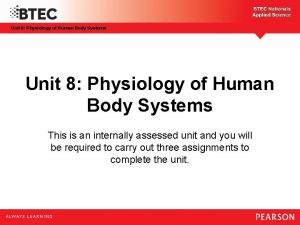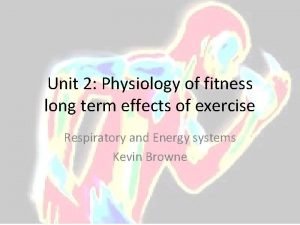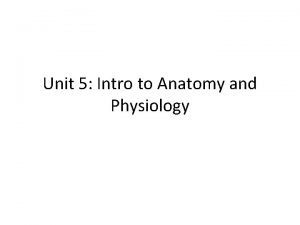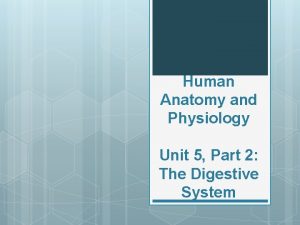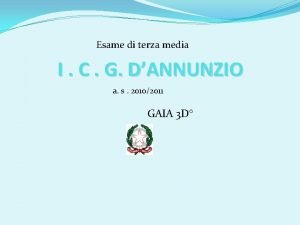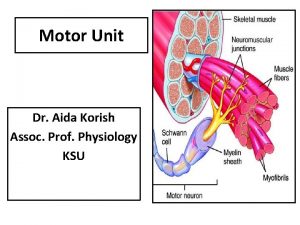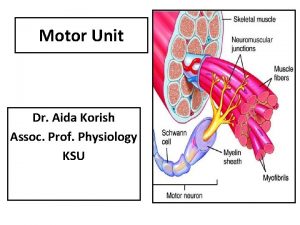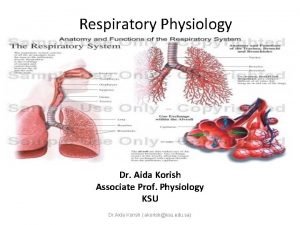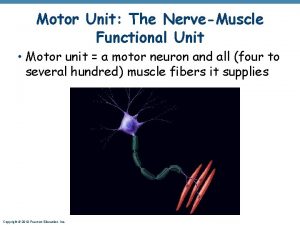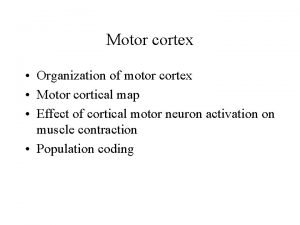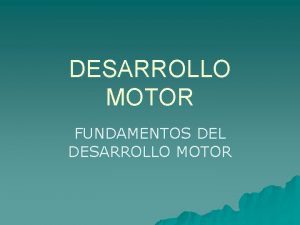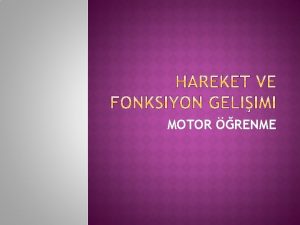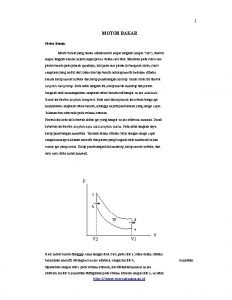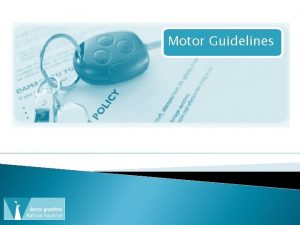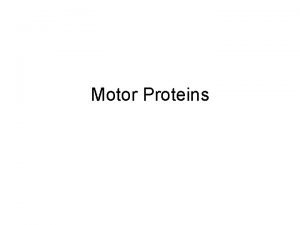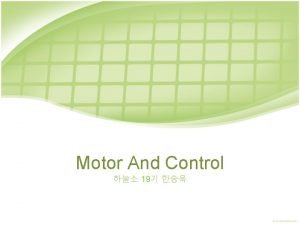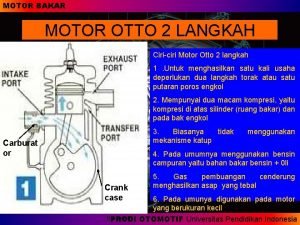Motor Unit Dr Aida Korish Assoc Prof Physiology



















- Slides: 19

Motor Unit Dr. Aida Korish Assoc. Prof. Physiology KSU

Objectives At the end of this lecture you should be able to: 1 - Recognise the organization of the nervous system. 2 - Identify the differences between central nervous system (CNS) & the peripheral nervous system (PNS). 3 - Discuss the functions and recruitment of the motor unit. 4 - Interpret the effect of motor units number on motor action performance.

Organization of Nervous System

Organization of The Nervous System Central Nervous System(CNS) Peripheral Nervous System (PNS) (Brain& Spinal Cord) Efferent Nerves (Motor) Afferent Nerves ( Sensory) From CNS to periphery From Periphery to CNS Autonomic Somatic Sympathetic Dr. Aida A. Korish( akorish@ksu. edu. sa) Parasympathetic 4

Nerve-Muscle Interaction The nervous system can be divided into central (CNS) and peripheral (PNS). PNS can be divided in terms of function into motor and sensory activities. Sensory Neurons: collects information from the various sensors located throughout the body and transmits them to the brain. Motor Neurons: conducts signals to activate muscle contraction. Skeletal muscle activation is initiated through neural activation. Sport Books Publisher 5

Neurons The building unit of the nervous system is the neuron which has – Cell body Nucleus – Dendrites – Axon Myelination Nodes of Ranvier – – – Axon terminals Synaptic end bulbs Neurotransmitter Acetylcholine (ACH)

α-motor neuron in the anterior horn cell A nerve is made up of a group of axons of neurons

Motor Unit

What is a Motor Unit ? § It is the α-motor neuron in the anterior horn cell (AHC) and all the muscle fibers it innervates (supplies) ﺗﻐﺬﻳﻬﺎ § All of these muscle fibers will be of the same type (either fast twitch or slow twitch). § Each muscle consist of a number of motor units. § When a motor neuron is activated, all the muscle fibers it innervates are stimulated and will contract.

Motor Unit The number of muscle fibers in a motor unit innervated by one motor neuron varies – Gastrocnemius 2, 000 muscle fibers per motor neuron – Extra ocular muscles < 10 muscle fibers per motor neuron Ratio of muscle fibers to motor neurons – Affects the precision of movement i. e small number is associated with more precise movements and vice versa.

More precise movements Less precise movements

• Groups of motor units often work together to help the contractions of a single muscle. • The number of muscle fibers within each motor unit can vary. • Muscles needed to perform precise movements generally consist of a large number of motor units and few muscle fibers in each motor unit e. g Hands and eyes muscles • Less precise movements are carried out by muscles composed of fewer motor units with many fibers per unit e. g Trunk muscles. 12

Motor unit recruitment: The group of motor units supplying a single muscle are called Motor Unit Pool. §The two ways the nervous system increases the force production is through § 1 -Recruitment of new motor units and 2 - Increasing stimulation frequency (rate coding). §The activation of one motor neuron will result in a weak muscle contraction. § The activation of more motor neurons will result in more muscle fibers being activated, and therefore a stronger muscle contraction.

Motor unit recruitment ﺗﻮﻇﻴﻒ ﺍﻟﻮﺣﺪﺍﺕ ﺍﻟﺤﺮﻛﻴﺔ • Recruitment of motor units is the progressive activation of a muscle by successive recruitment of contractile units (motor units) to accomplish increasing degrees of contractile strength (force). • When the AHC fires at slow rates , motor unit potentials (MUPs) will be at slow rate & the force of muscle contraction is weak. • If AHCs fire at very fast rates fast MUPs stronger contraction. Increasing frequency of action potentials resulting in stronger force of contraction 14

• The higher the motor unit recruitment, the stronger the muscle contraction. • The force produced by a single motor unit is determined by (1) the number of muscle fibers in the unit and (2) the frequency with which the muscle fibers are stimulated by their innervating axon. • Generally, this allows a 2 to 4 fold change in force. 15

Recruitment • Varying the number of motor units activated. Low stimulus threshold ↓ Larger motor units Higher stimulus threshold The Size Principle Amount of Force Required During Movement Largest motor units Highest stimulus threshold ↑ Nu m be r & S i z e o f M o to r U n i ts R e c r u i te d Small motor units

Recruitment and Size Principle

Rate Coding Rate coding refers to the motor unit firing rate. – Active motor units can discharge at higher frequencies to generate greater tensions. • Recruitment versus rate coding – Smaller muscles (ex: first dorsal interosseous) rely more on rate coding. – Larger muscles of mixed fiber types (ex: deltoid) rely more on recruitment. •

All or non role Motor Units Follows “all-or-none” principle – impulse from motor neuron will cause contraction in all muscle fibers it innervates or none. § In an electrodiagnostic testing (EMG , electromyography) for a patient with weakness, careful analysis of the motor unit action potential (MUAP) size, shape, and recruitment pattern can help in distinguishing a myopathy from neuropathy.
 Common lisp assoc
Common lisp assoc American angus login
American angus login Motor unit
Motor unit Unit 8: physiology of human body systems assignment 1
Unit 8: physiology of human body systems assignment 1 Agriscience unit 26 self evaluation answers
Agriscience unit 26 self evaluation answers Anatomy and physiology unit 7 cardiovascular system
Anatomy and physiology unit 7 cardiovascular system Unit 26 animal anatomy physiology and nutrition
Unit 26 animal anatomy physiology and nutrition Unit 2 physiology of fitness
Unit 2 physiology of fitness Long axis of body
Long axis of body Histological structure of oesophagus
Histological structure of oesophagus Pony motor starting method
Pony motor starting method Synchronous motor hunting
Synchronous motor hunting Ac motor vs dc motor
Ac motor vs dc motor Pony motor starting synchronous motor
Pony motor starting synchronous motor Aida persuasive message
Aida persuasive message Aida serrano
Aida serrano Aıda modeli
Aıda modeli Aida shafira
Aida shafira Aida verdi trama
Aida verdi trama La traviata tesina terza media
La traviata tesina terza media



